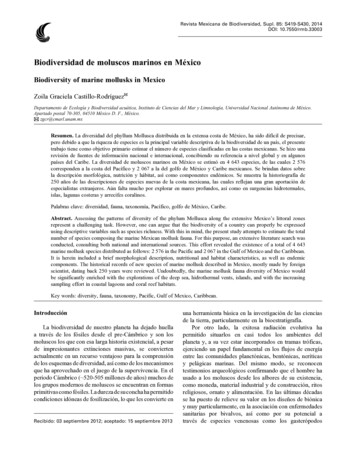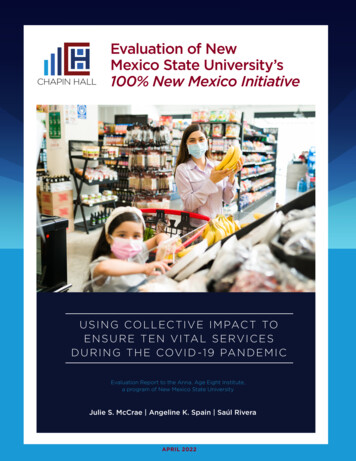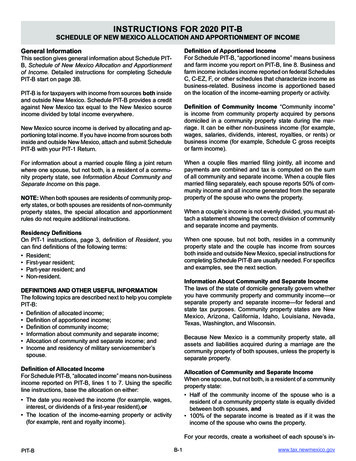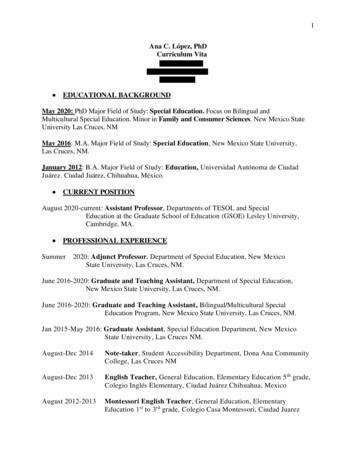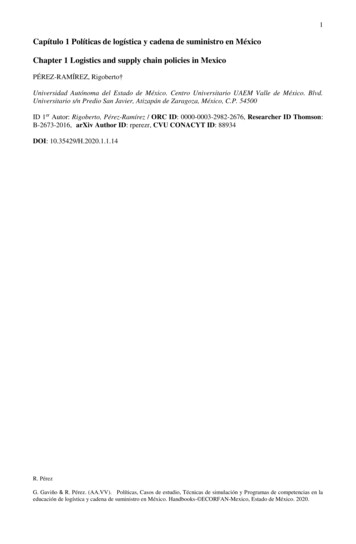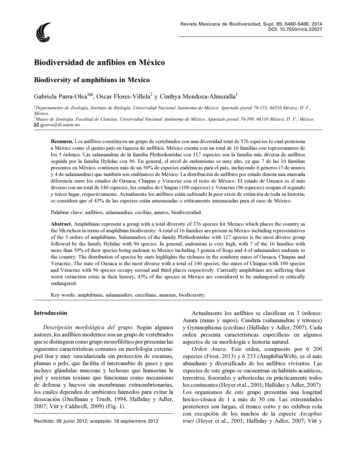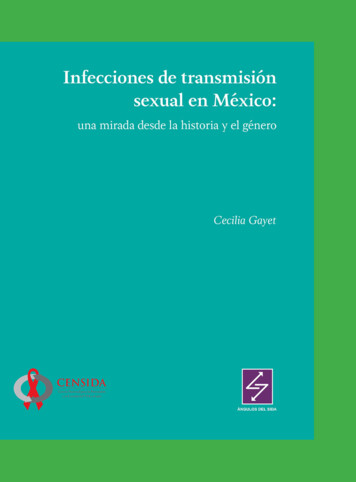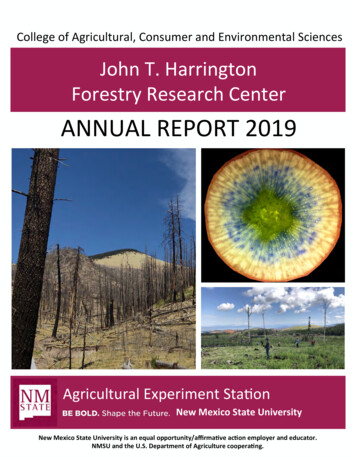
Transcription
College of Agricultural, Consumer and Environmental SciencesJohn T. HarringtonForestry Research CenterANNUAL REPORT 2019Agricultural Experiment Sta2onNew Mexico State UniversityNew Mexico State University is an equal opportunity/affirma:ve ac:on employer and educator.NMSU and the U.S. Department of Agriculture coopera:ng.
2019 Staff, John T. Harrington Forestry Research Center: Owen Burney, Associate Professor and SuperintendentTammy Parsons, Nursery ManagerJosh Trujillo, Senior Nursery LaborerLorenzo Gallegos, Senior Farm LaborerPartners and Collaborators: New Mexico Highlands UniversityNew Mexico Forest and Watershed Restoration InstituteUtah State UniversityPurdue UniversityOregon State UniversityNorthern Arizona UniversityUniversity of New MexicoSouthern Utah UniversityThe Nature ConservancyNational Park ServiceUS Forest ServiceNM State ForestryUS Geological SurveyInstitute of Applied EcologyWild Earth GuardiansInternational Union of Forest Research OrganizationsSanta Clara PuebloNM Soil and Water Conservation, MoraImerys MineralsPhilmont Scout Ranch – Boy Scouts of America
Table of Contents1. Introduction. 12. Forest Restoration Triangle (FORT). 23. CREST Grant. 24. FORT Advisory Board . 35. Forest Nursery Program . 46. Ongoing Research Projects. 47. Peer Reviewed Journal Articles . 78. Presentations. 119. Funding for 2018. 1210. Students . 1311. Field Tours at JTH FRC . 1312. Total Monthly Precipitation for JTH FRC 2018 . 14ii
1. IntroductionThe John T. Harrington Forestry Research Center (JTH FRC) with New Mexico StateUniversity (NMSU) is the only research program in the southwestern US thatfocuses on forest nursery technologies, tree improvement, and eco-physiology ofyoung forest trees to facilitate ecological restoration and/or commercialreforestation. These research interests are critical for establishing future forests inthe region.A subaward using McIntire-Stennis funds was provided to forestry faculty membersat the Department of Natural Resources Management (NRM) with New MexicoHighlands University (NMHU) in Fall 2018. This award will continue through theend of June 2019 and serves to promote the research and educational relationshipbetween the two forestry programs.The research center produced 5 publications during 2019. The topics for thepublications were: 1) regional differences in aspen seedling nursery production, 2)effects of growing media on polybag-raised whitegum, 3) plasticity of live oakseedlings under varied canopy conditions, 4) live oak response to vegetation andanimal control treatments, and 5) challenges and opportunities for maintainingponderosa pine in the southwestern US.External funding generated by the research center for 2019 totaled approximately 5,150,040. The primary source for funding came from the National ScienceFoundation Center for Research Excellence in Science and Technology grant. Othersources include: seedling sales for forest conservation, US Forest Service, NationalPark Service, tree improvement grants with the State of New Mexico, and theMcIntire-Stennis grant.With regards to teaching and education, the JTH FRC has hosted multiple tours forresearch scientists, land managers, and students (NMSU and NMHU). Additionally,our program is involved with two graduate students (1 PhD student at NorthernArizona University and 1 MS student at NM Highlands University).1
2. Forest Restoration Triangle (FORT)The Forest Restoration Triangle (FORT) is a partnership among: 1) the JTH ForestryResearch Center with New Mexico State University, 2) the Department of NaturalResources Management with New Mexico Highlands University, and 3) the NewMexico Forest and Watershed Restoration Institute. This partnership is focused onrestoring proper ecological function and ecosystem services to the forest landscapein New Mexico and the greater southwestern US.As our country, including the Southwest, has experienced the most destructivewildfires in history, it is more important than ever to research and implementeffective and efficient forest management and restoration strategies. FORT wasestablished in January 2018 to address these concerns through three main pillarscommon to other university/college forestry programs: research, education, andoutreach/extension.The FORT partnership continues to improve forest health conditions throughoutthe southwestern region. In 2019, the Collaborative Forestry Lab was successful incompleting all plant tissue analyses for the drought conditioning study with theassistance of student workers at New Mexico Highlands University. However, thebiggest achievement of the FORT partnership in 2019 was a successful award withthe Center for Research Excellence in Science and Technology (CREST) sponsoredby the National Science Foundation (NSF) (see below).3. CREST AwardIn December of 2019, the FORT program was awarded 5 million over 5 years bythe CREST program sponsored by NSF. This grant provides support to the researchcapabilities of minority-serving institutions through the establishment of centersthat effectively integrate education and research. The center aims to advance theunderstanding of the effects of restoration activities on forested areas in NewMexico through multidisciplinary research, education and stakeholdercollaborations. It also will provide science-based solutions for private, tribal, stateand federal forest managers, who face the threat of catastrophic fires due to2
overgrown forests and the inability of post-fire plant communities and ecosystemsto naturally regenerate.The role of NMSU as co-principal investigator on the CREST grant is to administerSubproject 1 of the grant. This subproject with NMSU has a budget of 1,057,666over 5 years. The research objective of this subject is to assess a nucleationstrategy matched with improved seedling stocktypes for forest restoration efforts.4. FORT Advisory BoardThe FORT Advisory Board was formed in January 2018. In 2019, there were twomeetings (Jan 2019 and Aug 2019). The board members were critical to the successin obtaining the CREST grant. Additionally, they helped the Forestry program at NMHighlands University secure accreditation by the Society of American Foresters.FORT Advisory Board Mission:The mission of the Advisory Board is to provide strategic guidance and direction forthe scientific (both applied and foundational), educational, and outreach programsfor all three institutions (FORT), both independently and collaboratively. It plays akey role in advocating the need for continued research, education, and outreach inforest restoration in New Mexico and within the greater southwestern US.FORT Board Members:Kent Reid – NMFWRIBrent Racher – NM Forest Industry AssociationJosh Sloan – NMHUOwen Burney – NMSUAnne Bradley – Nature ConservancyZander Evans – Forest GuildAndrew Frederick – NMSFJim Youtz – USFSEllis Margolis – US Geological SurveyAndi Thode – NAUDaniel Denipah – Santa Clara Pueblo3
5. Forest Nursery ProgramThe JTH FRC is the largest producer of forest nursery seedlings in New Mexico witha capacity of 300,000 per year. These seedlings are used for both research andconservation efforts. In 2019, the center produced approximately 55,600 seedlingsfor forest restoration purposes. At a planting density of 200 trees per acre, thisequates to approximately 278 acres of restored forests in New Mexico.6. Ongoing Research Projectsa. Drought-conditioning during nursery production influences physiology andresource allocation of Populus tremuloides and Pinus ponderosa seedlings.ObjectiveThis study was developed to test the effects of drought stress induced duringthe nursery growth phase on aspen and ponderosa pine seedlingmorphology and physiology.Impacts Preliminary results suggest that seedlings grown under limitedirrigation during the nursery phase improve plant hydraulics. Thistranslates to higher rates of both growth and survival compared to theoperational standard. In 2019, multiple nurseries and land managers from around the US areshowing interest in utilizing this protocol to improve forest restorationsuccess. Two manuscripts have been drafted and will be submitted in Spring of2020.FundingMcIntire-Stennis Grant, NM Energy, Minerals, and Natural ResourcesDepartment (EMNRD), Imerys Mining Company, US Forest Service, and JTHFRC seedling program.4
b. Genetic variation in aridity adaptation among Pinus ponderosa populations.ObjectiveThe objective of this study is to examine aridity adaptability of ponderosapine populations from a range of temperature and precipitation.Impacts Two new planting sites were established in Summer of 2019. Preliminary results have shown a pattern of increasing survival inrelation to seed sources that are more southern or lower in elevation. One publications was produced on this topic with two more in draftform.FundingMcIntire-Stennis Grant and Northern Arizona Universityc. Assisted migration – defining seed transfer guidelines for Pinus ponderosa ina changing climate.ObjectivesThe objective of this experiment is to assess the effectiveness of movingsouthern seed sources of ponderosa pine to a northern latitude located inthe Valles Caldera National Park. Additionally, the use of log shadingmicrosite environments on seedling performance will be examined.Impacts Preliminary results are showing that southern seed sources areoutperforming local sources. However, the biggest impact on seedlingsurvival and growth is connected to the log microsite which improvessoil water retention for the seedling during dry conditions. A master’s level graduate student is near completion on this researchproject with a thesis and publication.5
FundingNational Park Service and McIntire-Stennis Grant.d. Southwestern white pine blister rust resistance gene conservation.ObjectiveDevelop a grafting and gene conservation orchard program for blister rustresistant Southwestern white pineImpacts A fourth grafting occurred from in Spring of 2019. The successfullygrafted seedlings will be outplanted in Fall 2020. Current outplanted grafted seedlings are thriving and will become thefuture seed orchard for SW white pine for the entire southwestern US.FundingUS Forest Servicee. Maritime forest restoration on the Southern Atlantic Coast.ObjectivesThe objective of this study is to conduct a comprehensive analysis of theeffects of animal browse, weed competition, and light requirements for liveoak restoration plantings in Coastal Georgia in three project phases.Impacts Results from the first three phases of this project suggest that live oakrestoration is most successful when seedlings are both protected fromdeer herbivory and absent of competing vegetation. Additionally,increasing overstory canopy area showed a significant decrease inseedling performance. Planting in clearcuts is currently recommended. Two publications were produced from this research.6
7. Peer Reviewed Journal Articlesa. Howe A, Landhäusser S, Burney OT, Long J, Mock K (2019). Regionaldifferences in aspen (Populus tremuloides Michx.) seedling response to anestablished nursery protocol. New Forests, 1-12.Abstract: In seedling-based reforestation operations, the seed source isknown to be an influential variable determining outplanting success.Adaptive variation among seed sources may also be an important factor inthe effectiveness of standardized nursery protocols for seedling production.This is particularly important for wide-ranging species, where regionaloptimizations of nursery protocols may be necessary to ensure a consistentproduction of quality seedling stock. Quaking aspen (Populus tremuloidesMichx.) is a widely distributed tree species in North America. However,research to date on nursery protocols specific to aspen has focused on seedsources from a limited region in western boreal Canada. A well-establishedprotocol has shown to be very effective for these aspen that uses a shootgrowth inhibitor designed to maximize desirable seedling quality traits foroutplanting success. We used this protocol on seeds sourced from twodifferent regions in the southwestern portion of the species range (Utah andNew Mexico, USA) and compared their response in the same nurseryenvironment to that of a seed lot from Alberta, Canada to determinewhether this protocol is also applicable for these very different regions.Seedlings from Utah and New Mexico differed significantly in their responseto the protocol from the Alberta source, developing smaller root-to-stemratios and sequestering less carbohydrate and nutrient reserves. Seedlingsfrom Utah and New Mexico sources also differed from each other, with NewMexico seedlings growing larger according to all metrics. These resultsindicate that nursery protocols will benefit from regional modification inorder to optimize seedling stock quality and trait consistency.7
b. Shalizi N, Goldfarb B, Burney OT, Shear T (2019). Effects of five growingmedia and two fertilization levels on polybag-raised Camden whitegum(Eucalyptus benthamii Maiden & Cambage) seedling morphology anddrought hardiness. Forests, 10 (7).Abstract: In developing countries, tree seedlings are often produced inpolybags filled with mixtures of locally available materials. Seedling growthand quality can be affected by the type and amount of these substrates usedin the mixture. Differences in seedling growth and quality can also besignificantly affected when fertilization is employed during the nurserygrowing period. In this study, we assessed the effects of five differentgrowing media and two fertilization regimes on nursery growth, seedlingmorphology and early post-planting response to drought of Eucalyptusbenthamii (Maiden & Cambage) seedlings. First, we evaluated the effects ofeach media by fertilizer treatment combination on morphological attributesduring a nursery growing period. Seedlings raised in fertilized media withoutrice hulls yielded higher growth, root dry mass, shoot dry mass, total drymass, Dickson quality index (DQI) scores, and number of first order lateralroots (FOLRs). Root to shoot ratio (R:S ratio) was, however, greater in nonfertilized media that contained rice hulls. We then conducted a simulatedoutplanting and drought hardiness experiment, in which seedlings wereplanted in 13.2 L containers and irrigated for one month, followed by theimposition of drought stress. Seedlings in fertilized media composed of sand,topsoil and compost showed greater growth than those in rice hullcontaining media, during the irrigation phase. With the discontinuation ofirrigation and prevention of precipitation reaching the seedlings, seedlingsgrown in non-fertilized media containing rice hulls survived longer thanthose in other media. There were not large differences in survival amongother media or between fertilized and other non-fertilized seedlings.Seedling total size and shoot height at the time of planting played a majorrole in survival. Smaller seedlings with smaller shoot sizes and greater R:Sratios survived longer. This study demonstrates that growing media andfertilization can be manipulated to affect seedling morphology in the nursery8
and, ultimately, seedling performance and survival under water stressedconditions.c. Thyroff E, Burney OT, Mickelbart M, Jacobs D (2019). Unraveling shadetolerance and plasticity of semi-evergreen oaks: insight from maritime forestlive oak restoration. Frontiers in Plant Science, 10.Abstract: Quercus spp. (oaks) are generally intermediate in shade tolerance,yet there is large variation within the genus in shade tolerance and plasticityin response to varying resource availability. Ecophysiological knowledgespecific to semi-evergreen Quercus spp. from subtropical maritime forests islacking relative to temperate deciduous oaks. We studied the influence oflight availability and plant competition on leaf physiology and performanceof semi-evergreen Q. virginiana on a barrier island along the US southernAtlantic coast. Seedlings were underplanted in pine (Pinus taeda) plantationstands with varying overstory density (clearcut, heavy thin, light thin, andnon-thinned; creating a gradient of understory light availability) andvegetation (no competition removal or herbaceous competition removal)treatments. After two years, seedling survival was higher with increasinglight availability (clearcut heavy thin light thin non-thinned). Seedlinggrowth (i.e., diameter, height, and crown width) increased similarly withincreasing thinning intensity, while vegetation control was mainly beneficialto seedling growth in clearcuts. These responses were partially explained byfoliar nitrogen and leaf trait measurements, which followed the samepattern. Q. virginiana seedlings demonstrated high plasticity in their abilityto acclimate to varying resource availability, as indicated by light responsecurves, specific leaf area, stomatal density, stomatal pore index, andmaximum theoretical stomatal conductance. Light compensation andsaturation points illustrated seedling capacity to increase net CO2assimilation with increased light availability. Leaves on trees in the high lightenvironment had the highest net CO2 assimilation, stomatal density,stomatal pore index, maximum theoretical stomatal conductance and lowestspecific leaf area. Although we demonstrated the relative shade tolerance of9
Q. virginiana in lower light environments (i.e., heavy and light thin plots), thissemi-evergreen species shows high plasticity in capacity to respond tovarying resource availability, similar to other Quercus spp. from mesic andMediterranean environments.d. Thyroff E, Burney OT, Jacobs D (2019). Herbivory and competing vegetationinteract as site limiting factors in maritime forest restoration. Forests, 10(11).Abstract: Herbivory and competition during the regeneration phaseinfluence forest successional dynamics. We demonstrated the importance ofusing the Target Plant Concept to identify and overcome site limiting factorsfor subtropical maritime forest restoration associated with deer browsingand competition. Quercus virginiana Mill. (live oak) bareroot seedlings wereplanted into clearcuts along the US Southern Atlantic coast with differenttreatment combinations of herbivory control (fenced or non-fenced) againstwhite-tailed deer (Odocoileus virginianus Zimm.) browsing and competingvegetation removal (none, one-year, or two-years). After three growingseasons, mean seedling survival was 61% with no significant treatmentdifferences. Control of browse and vegetation interacted to facilitate growthof live oak; seedlings were significantly larger for all response parameters(diameter, height, crown width) when fenced and treated with vegetationcontrol. Removal of vegetation improved seedling performance only infenced plots, however, indicating a shift in pressure from herbivory tocompetition as the most limiting site factor when deer were excluded. Afterthe second growing season, foliar nitrogen was greater in fenced plots thannon-fenced plots and greater in two-year vegetation control subplots thannon-vegetation control subplots. This result, however, was absent after thethird growing season. Three years after clearcutting, there was no evidenceof Q. virginiana natural regeneration in non-fenced plots. Even with artificialregeneration in non-fenced plots, Q. virginiana growth was slow, indicatingthat herbivory was a key limiting factor. Our findings illustrate theimportance of accounting for site limiting factors and may aid in developing10
management prescriptions to promote semi-evergreen oak regeneration inecosystems with high pressure from herbivory and competing vegetation.e. Kolb T, Dixit A, Burney OT (2019) Challenges and opportunities formaintaining ponderosa pine forests in the southwestern U.S. Tree Planters'Notes. 62(1-2) 104-112.Abstract: Deforestation caused by wildfire and bark beetle attacks insouthwestern ponderosa pine (Pinus ponderosa Douglas ex P. Lawson & C.Lawson.) forests have increased over the past century due to climatewarming. Continued warming is expected to increase deforestation.Ponderosa pine regeneration after deforestation often is inadequate in theregion. Opportunities exist for active management to mitigate deforestation.First, planting can promote reforestation, but survival of planted seedlings isgenerally poor and highly variable among sites. The region needs moreresearch about improving early seedling performance. Secondly, improvingaridity adaptation of planted seedlings by seed source selection mayimprove outplanting performance. New common garden studies of seedlingaridity adaptation of Arizona and New Mexico provenances suggest geneticvariation in aridity adaptation among populations. Early results show geneticvariation in survival under extreme drought conditions. Greenhouseexperiments are investigating genetic variation in mechanisms of ariditytolerance. Promotion of forest recovery using these emerging approacheswill be critical for sustaining forests in the increasingly arid southwesternU.S.8. Presentationsa. Dixit A, Kolb T, Burney OT, Mock K. “Differences in seedling droughtadaptation between southwestern provenances of ponderosa pine”. 15thBiennial Conference of Science and Management for the Colorado Plateauand Southwest Region, Flagstaff, AZ. (Sep 9-12, 2019)11
b. Dixit A, Kolb T, Burney OT, Mock K. “Differences in drought adaptationbetween southwestern provenances of ponderosa pine”. 12th NorthAmerican Forest Ecology Workshop, Flagstaff, AZ. (Jun 23-27, 2019)c. Pinto J, Burney OT, Sloan J. "Overcoming limiting factors to seedlingestablishment: physiological, spatial, and temporal tactics", 8th WorldConference on Ecological Restoration: Restoring Land, Water & CommunityResilience, Society of Ecological Restoration, Cape Town, South Africa,(Sep 25, 2019).d. Burney OT. "Use of the Target Plant Concept to Promote Successful Post-FireForest Restoration", Reforestation after Fires, Southwest Fire ScienceConsortium, Webcast. (April 9, 2019)e. Burney OT. "Pu’u Wa’awa’a Demonstration Thinning", Advisory BoardMeeting, Tropical Hardwood Tree Improvement Research Center, Hilo, HI.(January 28, 2019).9. Funding for 2018Our receipt of external funding for 2019 was approximately 5,150,040.a. Burney OT (Co-Principal), Reid K (Principal), Cespedes B (Co-Principal),Conley C (Co-Principal). "CREST Center for Forest Restoration Triangle",Sponsoring Organization: National Science Foundation/New MexicoHighlands University. NMSU Co-PI Award: 1,057,671 (NMSU),Total Award: 5,000,000.b. Burney OT (Principal). "Conservation of Blister Rust Resistant SouthwesternWhite Pine through Clonal Propagation", Sponsoring Organization: USDepartment of Agriculture/Forest Service. Total Award: 15,000.12
c. Burney OT (Principal). "Defining Seed Transfer Guidelines and PlantingStrategies for Ponderosa Pine (Pinus ponderosa) to Aid in Post-Fire Recoveryin the Jemez Mountains", Sponsoring Organization: US Department ofInterior/National Park Service. Total Award: 50,000.d. Burney OT (Principal). "Tree Improvement and Forestation Plan", SponsoringTotal Award: 8,000.e. Burney OT (Principal). "Seedling Conservation for EMNRD Forestry Division",Sponsoring Organization: NM Energy, Minerals, and Natural ResourcesDepartment. Total Award: 47,040.f. Burney OT (Principal). “McIntire Stennis”, Sponsoring Organization:USDA.Total Award: 30,000.10. Studentsa. Jon Woerheide (MS), New Mexico Highlands University, “Seed transferguidelines for Pinus ponderosa in the East Jemez Mountains”.Advisor: Dr. Joshua Sloan, New Mexico Highlands University.Currentb. Aalap Dixit (PhD), Northern Arizona University, “Genetic variation in aridityadaptation among Pinus ponderosa populations”.Advisor: Dr. Tom Kolb, Northern Arizona UniversityCurrent11. Field Tours at JTH FRCa. General Public. “JTH FRC Field Day”. Audience: public, landowners, scientists,legislators, 50 participants. (September 2019)b. Mora County School System. “Outdoor Classroom”. Audience: middle schoolkids, 200 participants. (October 2019)13
12. Total Monthly Precipitation for JTH FRC 2019Month L 16.9114
Therole of NMSU as co-principalinvestigator on the CREST grant is to administer Subproject1 of the grant. This subproject with NMSU has a budgetof 1,057,666 over5 years. The research objective of this subject is to assess a nucleation strategy matched with improved seedling stocktypes for forest restoration efforts. 4. FORT Advisory Board


